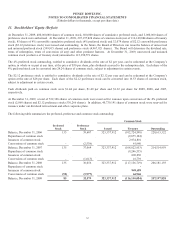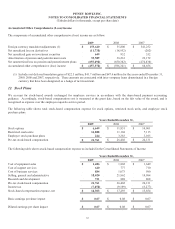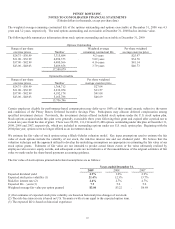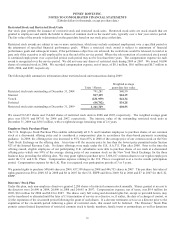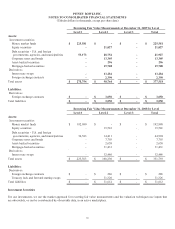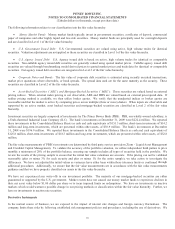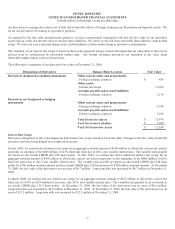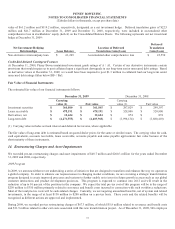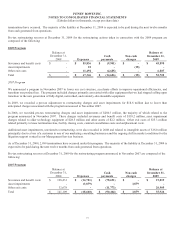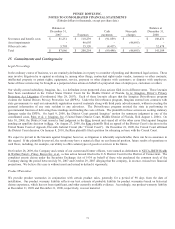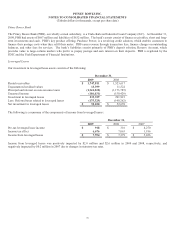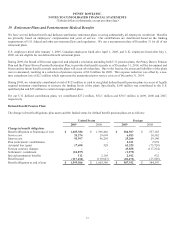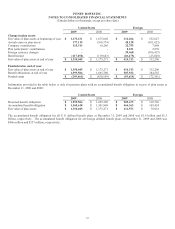Pitney Bowes 2009 Annual Report Download - page 90
Download and view the complete annual report
Please find page 90 of the 2009 Pitney Bowes annual report below. You can navigate through the pages in the report by either clicking on the pages listed below, or by using the keyword search tool below to find specific information within the annual report.
PITNEY BOWES INC.
NOTES TO CONSOLIDATED FINANCIAL STATEMENTS
(Tabular dollars in thousands, except per share data)
72
value of $61.2 million and $119.2 million, respectively, designated as a net investment hedge. Deferred translation gains of $22.5
million and $41.7 million at December 31, 2009 and December 31, 2008, respectively, were included in accumulated other
comprehensive loss in stockholders’ equity (deficit) on the Consolidated Balance Sheets. The following represents our net investment
hedge at December 31, 2009:
Net Investment Hedging
Relationships Loan Balance
Location of Deferred
Translation Gain (Loss)
Deferred
Translation
Gain (Loss)
Non-derivative intercompany loan $ 61,209 Accumulated other comprehensive loss $ 22,550
Credit-Risk-Related Contingent Features
At December 31, 2009, Pitney Bowes maintained investment grade ratings of A / A1. Certain of our derivative instruments contain
provisions that would require us to post collateral upon a significant downgrade in our long-term senior unsecured debt ratings. Based
on derivative values at December 31, 2009, we would have been required to post $1.3 million in collateral had our long-term senior
unsecured debt ratings fallen below BB- / Ba3.
Fair Value of Financial Instruments
The estimated fair value of our financial instruments follows:
December 31, 2009 December 31, 2008
Carrying
value (1) Fair value
Carrying
value (1)
Fair value
Investment securities $ 360,800 $ 361,845 $ 297,829 $ 299,307
Loans receivable $ 478,191 $ 478,191 $ 528,800 $ 528,800
Derivatives, net $ 12,624 $ 12,624 $ 874 $ 874
Long-term debt $ (4,271,555) $ (4,409,961) $ (3,990,134) $ (3,880,418)
(1) Carrying value includes accrued interest and deferred fee income, where applicable.
The fair value of long-term debt is estimated based on quoted dealer prices for the same or similar issues. The carrying value for cash,
cash equivalents, accounts receivable, loans receivable, accounts payable and notes payable approximate fair value because of the
short maturity of these instruments.
14. Restructuring Charges and Asset Impairments
We recorded pre-tax restructuring charges and asset impairments of $48.7 million and $200.3 million for the years ended December
31, 2009 and 2008, respectively.
2009 Program
In 2009, we announced that we are undertaking a series of initiatives that are designed to transform and enhance the way we operate as
a global company. In order to enhance our responsiveness to changing market conditions, we are executing a strategic transformation
program designed to create improved processes and systems to further enable us to invest in future growth in areas such as our global
customer interactions and product development processes. This program is expected to continue into 2012 and will result in the
reduction of up to 10 percent of the positions in the company. We expect the total pre-tax cost of this program will be in the range of
$250 million to $350 million primarily related to severance and benefit costs incurred in connection with such workforce reductions.
Most of the total pre-tax costs will be cash-related charges. Currently, we are targeting annualized benefits, net of system and related
investments, in the range of at least $150 million to $200 million on a pre-tax basis. These costs and the related benefits will be
recognized as different actions are approved and implemented.
During 2009, we recorded pre-tax restructuring charges of $67.3 million, of which $55.8 million related to severance and benefit costs
and $11.5 million related to other exit costs associated with this new transformation project. As of December 31, 2009, 548 employee


